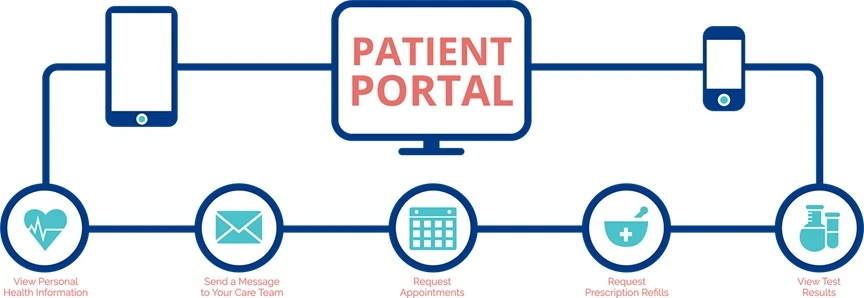The challenges of healthcare’s digital transformation
Healthcare is the most innovative industry, with the constant birth of modern hardware. Yet, in internal digital transformation, healthcare businesses are lagging in low software adoption and complex data-handling process. There is a significant amount of paperwork and manual tasks going on in healthcare.
While they understand the need for digital transformation, their IT Department often falls behind with legacy system and vendor lock-in. Thus, it leads to software that can’t be used. They return of manual processes. Imagine you spend a day examining dozens of patients, dealing with critical situations, and still have to deal with reports and paperwork at the end of the day.
On the other hand, healthcare businesses don’t have that much finance to invest in top-notch custom applications. Most of the budget is allocated for what matters more: the hardware and facilities. Therefore, following the idea of building applications from scratch is expensive for many.
The long-term effects are dreadful healthcare workers and unsatisfied patient experiences. This slow-to-convert digital transformation pushes healthcare businesses to look for new solutions. This is when low-code healthcare comes in clutch!
What is low-code?
The term “low-code” refers to an application development approach that leverages the power of graphical user interfaces, drag-and-drop builders and minimal code. Citizen developers and business users with little to no traditional coding experience can use low-code to create powerful and high-functioning enterprise applications to address various tasks, processes, and market challenges.
Low-code application development platforms offer enterprises an unparalleled opportunity to accelerate digital transformation. As a healthcare organization, you should look for a low-code platform with these features:
- Mobile, tablet, and desktop device compatibility
- HIPAA-compliant cloud hosting
- Interoperability with legacy and other health IT systems
Still skeptical about low-code? Here’s our full guide on What Is Low-code, Types & Use Cases
Why should you use low-code in healthcare
So, why should we consider using low-code for the healthcare industry instead of other development methods?
- Speed up development and time-to-market: The low-code approach reduces engineering effort by providing boilerplate code, reusable components, and pre-built templates to speed up development. Creating an application from building blocks is faster than building it from scratch. This seems like a limitation, but remember that low-code platforms allow you to customize any part of your interest.
- Easily scalable architectures: Supporting scalable cloud-native SaaS and even on-premises architecture enables you to scale resources based on uptime and cost requirements.
- Healthcare workers involved in the production: Because of the ease of use and accessibility of low-code, more people in the healthcare industry, including analysts, doctors, nurses, and business technicians, can contribute to the process
- Lower development and maintenance expenses: Low-code for healthcare relieves strain on IT departments and lowers overall software development life-cycle costs. This allows you more time to validate your concept and secure potential investment.
- Compatibility with third-party software and legacy systems: If you’re still using outdated legacy systems, replace them with modern third-party technologies such as telehealth, administrative management, and scheduling software
- By enabling rapid application testing, low-code development can help healthcare organizations accelerate the delivery of new enterprise applications and software. Rapid application development typically involves fast prototyping processes and constant iteration testing to shorten the development cycle.
Explore both sides: Low-code Benefits & Disadvantages For Businesses
6 ways to leverage low-code in healthcare
Support documentation & automate back-office task
Drug trials, for example, require consistent iteration testing and precise documentation. On the other hand, keeping track of these iterations can be highly time-consuming and error-prone. Healthcare organizations can significantly accelerate internal processes by automating numerous documentation stages.
You can build a centralized and scalable low-code database for client information, test results, and clinical trial performance as detailed as you want. This also means it can automate data-related processes such as classifying, analyzing and storing.
Low-code for healthcare is more than just documentation. Other examples of using low-code in back-office work to relieve the burden, operate faster, and increase efficiency include:
- Creating an employee portal
- Developing accounting application
- Building a custom low-code ERP system
- Creating agents to automate simple and repetitive tasks
Create client portals

Using client portals, your pass-by buyers can be part of your next long-term customers. Many patients hesitate to go to the hospitals due to the limited support before appointments. To navigate this, hospitals use client portals to store information and answer patients’ questions online, dispelling concerns about travel time and ensuring seamless treatment.
Other Uses Of Low-code Healthcare Portals Include
- Tracking test results update: It removes the frustration of waiting as they can know when to get a re-check with just a few clicks.
- Booking appointments: No more sitting and waiting as the lengthy paperwork is being processed. Appointment scheduling software can help you improve the patient experience and save resources. Besides, you can create simple SMS or email notifications to remind patients of upcoming appointments and reduce no-shows/ cancellations.
- Online patient intake forms: A suitable intake form should contain questions about personal lifestyles, medical histories, symptoms description, and guidance to the next steps (call for support, booking appointments, choosing a doctor). Digitizing this data collection processes will save time, reduce human error, and simplify file management for administrative staff.
- Tracking medical/ vaccine availability: Many prescription drugs and vaccines are not widely used, so it’s understandable not to always have them in storage. Provide your clients with a tool to check for them before spending time moving to the hospital.
- Allowing patients to check past appointments.
- Feedback tools or doctor reviews for employee performance review.
- Automatically notify their next appointments.
Optimize asset management
Low-code tools with advanced artificial intelligence (AI) and machine learning (ML) can assist in streamlining daily operations, allocating hospital resources, delivering drugs to patients, identifying low-on-storage drugs, and managing supplies.
Furthermore, low-code healthcare can automate systems for managing regulatory compliance, such as patient documentation, insurance requirements, and external regulatory bodies efficiently and effectively than ever.
Develop healthcare analytic tools
Emory Healthcare is Georgia’s largest healthcare network, with 11 hospitals, 2,800 physicians, and 20,000 employees across 250 sites. The group wished to aggregate and analyze billing, claims, and other financial data affecting patient experience. They used low-code to build a decision-support system that integrated multiple data sources and supplemented their existing tools.
With its AI/ML features, low-code in healthcare can be a reliable predictive analytics tool for every business.
Facilitating remote healthcare
We have all been there. We know our health isn’t at its best stage, and the symptoms are unclear or urgent enough to go to the hospital. Still, we want an answer.

Because of this, telehealth is increasingly used to reduce physical interaction for less urgent patient needs. Low-code healthcare platforms can help with remote care planning by making patient assistance more accessible.
Improve patient experience with virtual agents and chatbots
Another feature that is becoming more common in low-code for healthcare is the ability to program intelligent chatbots. These chatbots respond to user needs in everyday dialogue using natural language processing (NLP), increasing self-service capabilities while decreasing human support.
These are just a few common examples of using low-code for healthcare. The sky is unlimited as low-code is made to build any types of applications. As long as you have the idea, low-code is a good technology to test it out before investing all your resources into customized software.
Real-life examples of using low-code for healthcare
Even though we all know that low-code isn’t perfect (yet), the platforms available today meet the needs of the most demanding businesses. To demonstrate our point, consider some real-world examples from the healthcare industry.
Patient referrals
The Royal Berkshire provides medical and surgical services with around 125,000 patient referrals annually across 40 specialist areas within the organization. However, manually processing referrals and synchronizing patients with the appropriate provider took a lot of work.
With a low-code healthcare tool, the Royal Berkshire NHS Foundation was able to automate their referral process. It takes 6x faster, saving the organization an estimated 15,000 work hours per year.
Centralized communication tool
Luz Sade, a leading Portuguese healthcare group, required a tool to provide medical personnel with content management, access control, and scheduling features. With a full-scale engineering team, the development was expected to take more than 9 months.
However, to reduce time-to-market, management chose a low-code healthcare platform and finished the customized software with a team of 7 in 4 months.
Homecare planning system
Saga HealthCare, one of the largest homecare agencies in the United Kingdom, needed to implement a new homecare scheduling system. The project’s initial budget was $16 million over 3 years. However, a low-code solution enabled the company to build the desired system in 6 months for less than $333,500.
Analytics platform for medical implants
A US hospital wanted to digitize transaction and billing management for implantable medical devices.
A standard technical stack would have taken the development team about a year to build an app with ten developers. However, the low-code platform enabled the company to create its app with 1 developer in 9 months.
The software assists in identifying contracting issues, analyzing invoices, and detecting cost-cutting opportunities. As a result, hospitals that use their solutions save approximately 30% on medical implants.
Top low-code healthcare platforms to use
Most healthcare employees are non-technical. And let’s be honest, they don’t have much time to learn to be one. For the best use of low-code for healthcare, you might consider an easy-to-use and flexible platform that anyone can quickly adopt.
Here are some of our suggestions
- Creatio: Using Creatio, users can develop any mobile application and process automation tools with its user-friendly interface, pre-built features, and customizable templates. This low-code healthcare tool is one of the simplest to learn and use, even with no coding knowledge.
- Microsoft PowerApps: Easily the best enterprise-level low-code healthcare platform. There is no limitation with PowerApps, thanks to its extensibility, scalable infrastructure, friendly interface, and flexible integration. Also, you can build applications on any system and device, ensuring seamless access for healthcare workers. Learn how PowerApps remove paperwork in Vitas Healthcare process.
- Mendix: Its interface is very appealing and stands out. It supports app development, workflow automation, and project management with a wide range of tools. Also, you can integrate Mendix with other systems such as healthcare core systems, ERP, and CRM.
- Zoho Creator: With more than 550 code blocks and design elements, Zoho helps businesses to build applications that run on all devices. Scalability is a strength of Zoho.
- Appian: A stylist interface and simple-to-use features are not the only things Appian offer. You can leverage this low-code healthcare platforms to enhance patient experience, mitigate paperwork and boost productivity.
Still looking for more choices? Here’s a list of the top 21 Low-code platforms to use!
Synodus is one of the first gold partners of Microsoft PowerApps and Salesforce in APAC for healthcare. Looking for consultation and coding support in Low-Code Development for your business?
Here we have teams of Low-code experts and ultimate tech stacks to help you rapidly create applications and optimize internal processes with no paperwork. View our portfolio!
Wrapping up
Healthcare providers benefit from robust applications that address their specific needs. Custom healthcare applications, however, are challenging to develop due to limited IT resources. You should utilize your business’ operation by using low-code healthcare to bridge the gap. Development cycles must be shortened to meet the demand of patients and healthcare professionals in real-time.
More related posts from Low-code blog you shouldn’t skip:
- 7 Top Choices Of Low-code Platforms For On-premises Application
- Using Low-code For IoT Development: Opportunity & Barriers
- 5 Top-notch Low-code Development Companies in Vietnam
How useful was this post?
Click on a star to rate it!
Average rating / 5. Vote count:
No votes so far! Be the first to rate this post.




